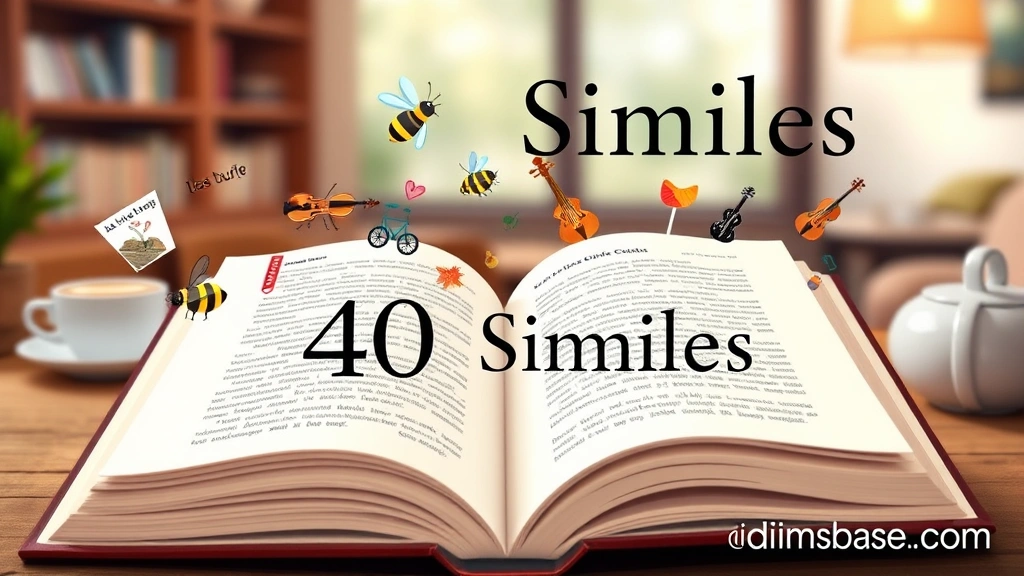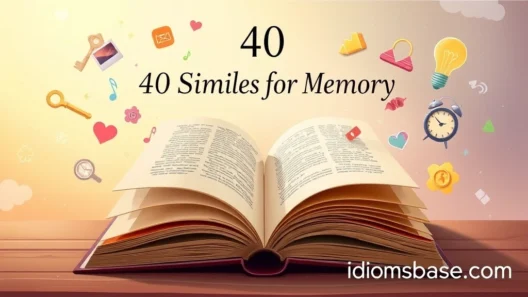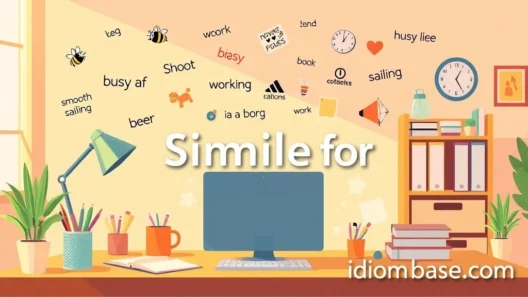Have you ever found yourself searching for the perfect phrase to describe a feeling, a person, or a situation? Sometimes, words alone just don't capture the essence, do they? That's where similes come in! These wonderful figures of speech, comparing two different things using "like" or "as," are like little magic wands for your language, making your descriptions vivid and memorable.
As adults, we navigate a complex world filled with nuanced emotions, intricate relationships, and diverse experiences. Relying on tired old phrases can make our communication feel a bit, well, flat. But fear not! Learning to wield similes effectively can transform your conversations, your writing, and even your thoughts. They're like a secret ingredient for captivating storytelling and clear expression.
In this article, we're diving into a treasure trove of 40 brilliant similes, crafted especially for the adult world. Whether you're looking to add a sparkle to your everyday chat, elevate your professional communication, or simply enjoy the artistry of language, you're in for a treat. Get ready to make your words sing!
Unlocking the Power of Similes
Why are similes so powerful, you ask? Think of it this way: they're like a shortcut to understanding. By linking something unfamiliar to something familiar, they help your audience grasp complex ideas quickly and emotionally. They paint pictures in the mind, evoke feelings, and make your message stick. Plus, they add a touch of elegance and wit to your language, making you sound more articulate and engaging. It’s like adding a dash of spice to a delicious meal!
For adults, mastering similes can be incredibly beneficial. In your career, they can make presentations more persuasive, emails more engaging, and networking conversations more memorable. In your personal life, they can deepen connections by helping you express empathy, convey humor, and share experiences in a truly relatable way. They're like a master key to better communication.
40 Similes for Adults to Elevate Your Language
Ready to expand your linguistic toolkit? Here are 40 fantastic similes designed to add depth, humor, and clarity to your adult conversations and writing. Each one is a little gem, waiting for you to polish and use!

- As busy as a one-armed paperhanger: For when someone is incredibly swamped with tasks.
- As clear as mud: Perfect for describing something utterly confusing or incomprehensible.
- As sharp as a tack: To praise someone's quick wit or intelligence.
- As cool as a cucumber: When someone remains calm and composed under pressure.
- As dry as a bone: Describing something completely devoid of moisture or interest.
- As fresh as a daisy: For someone looking vibrant and well-rested.
- As stubborn as a mule: When someone is unyielding and resistant to change.
- As light as a feather: To describe something very delicate or weightless.
- As strong as an ox: For someone with great physical strength.
- As blind as a bat: When someone has very poor eyesight.
- As quiet as a mouse: To describe someone or something making no sound.
- As hungry as a wolf: When someone is extremely famished.
- As quick as a flash: For something happening almost instantaneously.
- As proud as a peacock: When someone is openly displaying great satisfaction or arrogance.
- As keen as mustard: Eager and enthusiastic.
- As white as a ghost: When someone looks very pale, often from fear or illness.
- As slippery as an eel: To describe someone evasive or untrustworthy.
- As mad as a hatter: Used for someone behaving in a very eccentric or irrational way.
- As happy as a clam: Extremely content and cheerful.
- As brave as a lion: Exhibiting great courage.
- As free as a bird: Feeling completely unencumbered and unrestricted.
- As flat as a pancake: Describing something very thin and level.
- As right as rain: Feeling perfectly well or that everything is in order.
- As tough as nails: Resilient and not easily intimidated.
- As regular as clockwork: Happening at consistent intervals.
- As smooth as silk: Describing a very fine texture or an effortless process.
- As cold as ice: Someone lacking warmth or emotion, or a very low temperature.
- As dead as a doornail: Completely lifeless or defunct.
- As good as gold: Behaving perfectly or being highly valuable.
- As slow as molasses: Extremely sluggish.
- As clean as a whistle: Spotlessly clean or executed perfectly.
- As old as the hills: Extremely ancient.
- As easy as pie: Very simple to do.
- As fit as a fiddle: In excellent physical health.
- As graceful as a swan: Moving with elegant fluidity.
- As alike as two peas in a pod: Identical in appearance or nature.
- As heavy as lead: Extremely weighty.
- As bright as a button: Very intelligent and cheerful.
- As dark as pitch: Extremely dark, with no light.
- As fresh as morning dew: Pure, new, and invigorating.
Incorporating Similes into Your Daily Life
Now that you have this fantastic list, how do you start using them? It's like learning to ride a bike – you just have to start pedaling!
Tips for Seamless Integration:
- Start Small: Don't try to force a simile into every sentence. Begin by picking one or two that resonate with you and try to use them naturally in conversations or emails.
- Listen Actively: Pay attention to how others use descriptive language. This can spark ideas for your own simile usage.
- Read Widely: Books, articles, and even well-written social media posts often contain rich descriptive language. Notice how authors use similes to enhance their narratives.
- Practice in Writing: Writing is a great low-pressure environment to experiment. Try incorporating similes into your personal journal, creative writing, or even work reports.
- Don't Overdo It: Like any good spice, too much can ruin the dish! Use similes judiciously to make your language impactful, not overwhelming.
- Be Authentic: Choose similes that genuinely fit your personality and the context of your conversation. Forcing a simile that doesn't feel right will sound artificial.
Remember, the goal is to make your communication more engaging and effective, not to sound like a walking dictionary of figures of speech!
Frequently Asked Questions (FAQ)
Q1: What exactly is a simile?
A simile is a figure of speech that directly compares two different things, usually by using the words "like" or "as." The purpose is to make a description more vivid, imaginative, or emphatic. For example, "The cloud was like a giant cotton ball."

Q2: How is a simile different from a metaphor?
This is a great question! While both compare two unlike things, a simile uses "like" or "as" to make the comparison explicit (e.g., "life is like a box of chocolates"). A metaphor, on the other hand, states that one thing is another, implying the comparison without "like" or "as" (e.g., "life is a box of chocolates"). Metaphors are more direct and often more forceful.
Q3: Why should adults use similes in their communication?
Using similes as an adult can significantly enhance your communication. They make your language more expressive, memorable, and engaging. They help you convey complex ideas simply, add humor, build rapport, and demonstrate your command of language. It's like adding color to a black-and-white drawing – it makes everything pop!
Q4: Are there any common mistakes to avoid when using similes?
Yes, absolutely! One common mistake is using clichés too often. While some clichés are widely understood, overuse can make your language sound unoriginal. Another pitfall is making comparisons that are unclear or don't make sense in context. For example, "as bright as a brick" wouldn't work! Also, avoid using too many in one go; it can make your writing feel cluttered and dilute their impact.
Q5: Can I create my own similes?
You absolutely can and should! Creating your own similes is a fantastic way to develop your linguistic creativity. Think about the quality you want to describe (e.g., "awkwardness") and then brainstorm objects or experiences that share that quality (e.g., "a first dance," "a platypus"). Then, connect them using "like" or "as" (e.g., "The conversation was as awkward as a first dance"). The more you practice, the easier it becomes!
Key Takeaways
- Similes are powerful tools: They enhance communication by making descriptions vivid, memorable, and relatable.
- They use "like" or "as": This is the key identifier for a simile, explicitly linking two different things.
- Benefits for adults: Similes can boost professional presentations, personal storytelling, and overall linguistic flair.
- Practice makes perfect: Start incorporating similes gradually into your daily conversations and writing.
- Be creative and authentic: Don't be afraid to invent your own similes, but ensure they are clear and fit the context.
So, there you have it! A comprehensive guide to 40 similes for adults, designed to make your language sparkle. Integrating these into your vocabulary is like unlocking a new level in the game of communication. You'll find yourself expressing nuances and painting vivid pictures with words, making your interactions richer and more meaningful. It's truly a skill worth cultivating. Now, go forth and make your words sing!







